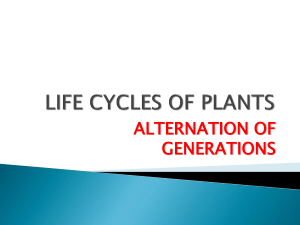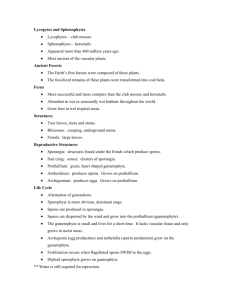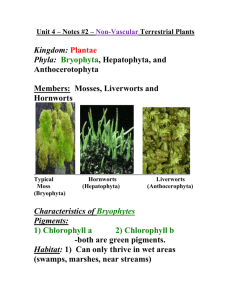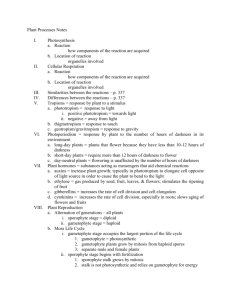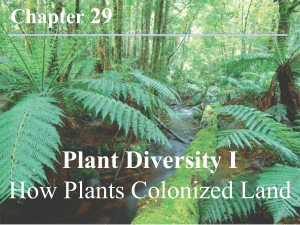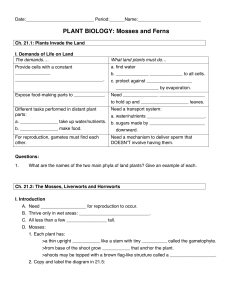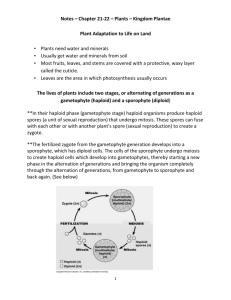Nonvascular plants - “bryophytes” transition between aquatic algae
advertisement
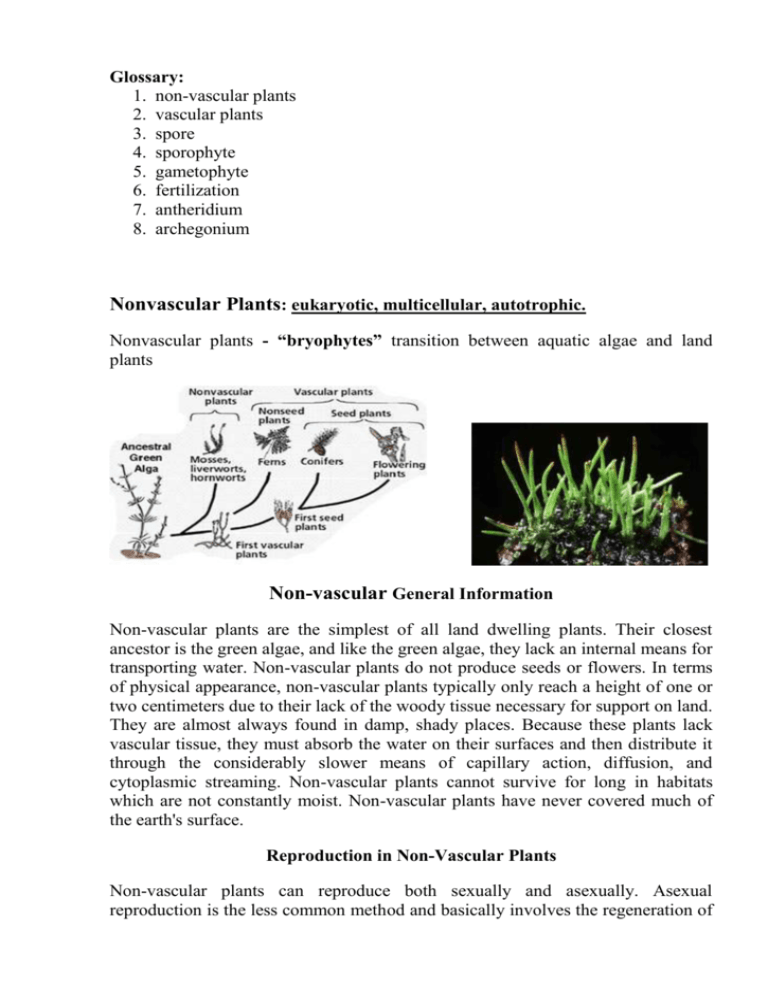
Glossary: 1. non-vascular plants 2. vascular plants 3. spore 4. sporophyte 5. gametophyte 6. fertilization 7. antheridium 8. archegonium Nonvascular Plants: eukaryotic, multicellular, autotrophic. Nonvascular plants - “bryophytes” transition between aquatic algae and land plants Non-vascular General Information Non-vascular plants are the simplest of all land dwelling plants. Their closest ancestor is the green algae, and like the green algae, they lack an internal means for transporting water. Non-vascular plants do not produce seeds or flowers. In terms of physical appearance, non-vascular plants typically only reach a height of one or two centimeters due to their lack of the woody tissue necessary for support on land. They are almost always found in damp, shady places. Because these plants lack vascular tissue, they must absorb the water on their surfaces and then distribute it through the considerably slower means of capillary action, diffusion, and cytoplasmic streaming. Non-vascular plants cannot survive for long in habitats which are not constantly moist. Non-vascular plants have never covered much of the earth's surface. Reproduction in Non-Vascular Plants Non-vascular plants can reproduce both sexually and asexually. Asexual reproduction is the less common method and basically involves the regeneration of plant material, leaves or other parts, that fall to the ground and create secondary plants which have new buds. Most non-vascular plants reproduce sexually and create gametes. ALTERNATION OF GENERATIONS: an alternation of multi-cellular haploid and diploid forms in the life history of an organism SPOROPHYTE: the diploid individual which produces reproductive cells called spores GAMETOPHYTE: the haploid individual which produces gametes note: the two generations alternate taking turns producing one another .Spores released from sporophytes germinate to form gametophytes, which in turn produce gametes.Then the union of two gametes (fertilization) results in a diploid zygote which gives rise to a new sporophyte. Phylums of Non-Vascular Plants Phylum Chlorophyta (green algae) Phylum Rhodophyta (red algae) Phylum Phaeophyta (brown algae, the kelps) Phylum Bryophyta (primitive land plants, mosses and liverworts) Mosses Kingdom Plantae Seedless Nonvascular Plants Includes mosses, liverworts and hornworts Lack vascular tissue (xylem and phloem) to carry water and food Have a Sporophyte and Gametophyte stage known as alternation of generations Gametophyte is dominant stage Reproduce by spores Division Bryophyta Mosses: Small, nonvascular land plants No true roots, stems, or leaves Most common bryophyte Grow on moist areas (brick walls, and on the trees) Some survive periodic dry spells, revive when H2O becomes available Must grow close together and have H2O to complete life cycle Sperm swims to egg through drops of water during fertilization H2O moves cell-to-cell by osmosis Sphagnum moss is known for its moisture holding capacity, absorbing up to 20 times its dry weight with water. LIFE CYCLE OF MOSSES: Mosses alternate between a haploid (n) gametophyte stage and a diploid (2n) sporophyte stage Gametophyte is the dominant generation Moss Gametophyte Moss Sporophyte Called alternation of generations The haploid gametophyte stage contains half the chromosome number and produces gametes (egg and sperm) Gametophyte stage is dominant in the moss's life cycle Gametophytes are photosynthetic and have root-like rhizoids The diploid sporophyte has a complete set of chromosomes and produces spores by meiosis Sporophyte of a moss is smaller than, and attached to the Gametophyte Sporophytes lack chlorophyll and depend on the photosynthetic gametophyte for food Sporophyte has a long, slender stalk topped with a capsule Capsule forms haploid (n) spores Moss Capsules Sexual Reproduction in Moss: Mosses produce 2 kinds of gametes (egg and sperm) Gametes of Bryophytes are surrounded by a jacket of sterile cells that keep the cells from drying out Female gametes or eggs are larger with more cytoplasm & are immobile Flagellated sperm must swim to the egg through water droplets for fertilization Moss gametes form in separate reproductive structures on the Gametophyte Archegonium and Antheridium Archegonium Antheridium Each Archegonium forms one egg, but each Antheridium forms many sperm Fertilization can occur only after rain when the Gametophyte is covered with water Sperms swim to the egg by following a chemical trail released by the egg A zygote (fertilized egg) forms that undergoes mitosis and becomes a Sporophyte Cells inside mature Sporophyte capsule undergoes meiosis and form haploid spores Haploid spores germinate into juvenile plants called protonema Protonema begin the Gametophyte generation Protonema Spores are carried by wind & sprout on moist soil forming a new Gametophyte Asexual reproduction in Mosses: Asexual reproduction in moss may occur by fragmentation or gemmae Pieces of a Gametophyte can break off and form new moss plants (fragmentation) Gemmae are tiny, cup shaped structures on the Gametophytes Raindrops separate gemmae from the parent plant so they can spread and form new Gametophytes Uses for Moss: Help decomposer dead logs Serve as pioneer plants on bare rock or ground Help prevent erosion Provide shelter for insects and small animals Used as nesting materials by birds and mammals Sphagnum or peat moss forms peat bogs (wet ecosystem) Peat is burned as fuel in some areas Liverworts: Nonvascular Undergo alternation of generations with Sporophyte attached to Gametophyte Gametophytes are green and leafy and the dominant generation Liverwort Need abundant water for fertilization Reproduce by spores Grow on moist rocks or soil Reproduce asexually by gemmae and by growing new branches Hornworts: Small, nonvascular bryophytes Gametophyte leafy like liverworts Archegonia and antheridia form inside the plant After fertilization, zygotes develop into long, horn-shaped Sporophytes Horn-shaped Sporophytes capable of photosynthesis so not completely dependent on Gametophyte Hornwort
